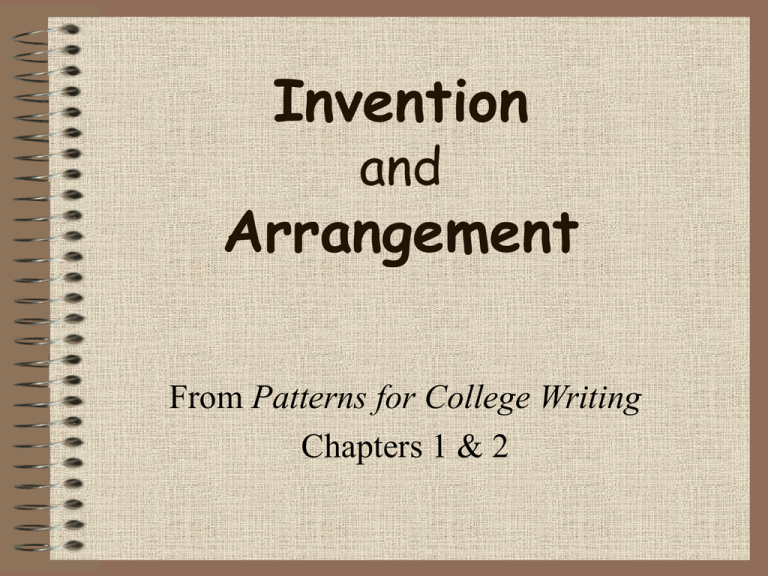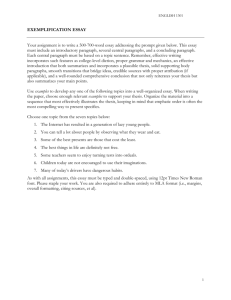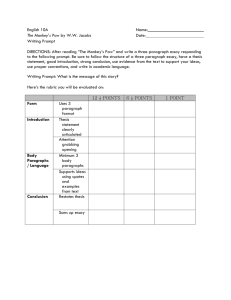Invention and Arrangement
advertisement

Invention and Arrangement From Patterns for College Writing Chapters 1 & 2 Invention (prewriting) • Before you start writing: – Consider the assignment – Explore your subject – Decide what you want to say about it Understanding the Assignment • What are you being asked to do? • Look for key words: compare, contrast, analyze, describe, summarize, etc. • Length (pp. 16 & 19) • Purpose (pp. 16-17 & 19) • Audience (pp. 17 – 19) • Occasion (pp. 18-19) • Knowledge (pp. 18-19) Understanding the Assignment • LENGTH OF THE PAPER • The shorter the essay, the more narrow the topic needs to be • A summary of a chapter or article is much shorter than the original; “an analysis of a poem will usually be longer than the poem itself” (16) Understanding the Assignment • PURPOSE • To persuade? Analyze? Compare/contrast? Etc. • AUDIENCE • Group or individual? How much does your audience know about the subject? • OCCASION • Academic or personal? Journal or formal essay? • KNOWLEDGE • How much do you know about your subject? What are your opinions about it? Chap. 1, Exercises 1 & 2 • Exercise 1: Decide whether the following topics are appropriate for the given limits. Why or why not? (19). • Exercise 2: Consider the different way in which you speak to different people in your life (20). Moving from Subject to Topic • General subjects need to be narrowed to specific topics (see p. 20). • Ask yourself questions to help you narrow a topic (see p. 21). • Examples: Try to narrow general subjects like “Iraq” or “Fast Food” or “American Idol” Chap. 1, Exercises 3 & 4 • Exercise 3: Are these topics narrow enough for a short essay? (22). • Exercise 4: Generate several specific topics from each of the listed general subjects (22). Forms of Prewriting • • • • • Freewriting (23) Brainstorming (25) Journal Writing (25) Clustering (27) Outlining (28) Understanding Thesis & Support • A THESIS is the main idea of your essay. In your introduction, you need to clearly state your thesis, and you need to support it consistently in the body paragraphs. • A thesis statement isn’t just stating your essay’s purpose, nor is it a statement of fact (30). • See pp. 30-31 for examples • Not necessary to write “My thesis is . . .” (32) Thesis cont. & exercises • A thesis statement can’t include all of the points you’re going to discuss in your essay – it should state, as specifically as possible, the overall main point your essay is going to make. • See Exercises 8 & 9 Chapter 2: Arrangement • See the checklist on p. 38 to help you determine they type of essay you are writing. This will help you determine the arrangement, or organization. • All essays should have an introduction, a body, and a conclusion The Introduction An introduction should: • Introduce your subject • Get your readers’ attention • Include your thesis statement The Introduction • 8 ways to introduce an essay (39-40) – – – – – – – – 1). 2). 3). 4). 5). 6). 7). 8). Background information A definition An anecdote or story A question A quotation A surprising statement A contradiction A fact or statistic The Body Paragraphs • Develops & supports your thesis • Each body paragraph should be: – Unified – Coherent – Well-developed Body Paragraphs: Unity • Unity means that all of the ideas are related. Each sentence should relate to the main idea of the paragraph (41). • Use topic sentences to state the main idea of a paragraph (usually the first sentence in a body paragraph) Body Paragraphs: Coherence • If a paragraph is coherent, it means that it makes sense . . . “its sentences are smoothly and logically connected to one another” (42). • 3 Techniques to achieve coherence: – Repeat key words – Use pronouns to refer to key nouns from the Previous sentence – Use transitions (see p. 43) Body Paragraphs: Development • A well-developed paragraph contains examples, reasons, etc. that help support the main idea (thesis) of the essay • Types of support (see p. 44) The Conclusion • Should briefly reinforce your main idea (thesis and purpose) • Avoid the phrase “In conclusion” (46). • 4 ways to conclude an essay: – 1). Review your key points; restate your thesis – 2). Recommend a course of action – 3). Make a prediction – 4). End with a “relevant quotation” (47) Constructing an Outline • A formal outline is detailed, provides you with an exact order, specific information that you want to include • Writing an outline provides you with a good chance to see whether all of your ideas work together and are well-supported • See example on p. 48





